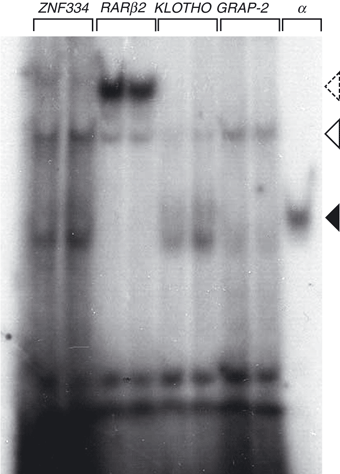Varying expression of four genes sharing a common regulatory sequence may differentiate rheumatoid arthritis from ageing effects on the CD4(+) lymphocytes
- PMID: 20738421
- PMCID: PMC3015077
- DOI: 10.1111/j.1365-2567.2010.03341.x
Varying expression of four genes sharing a common regulatory sequence may differentiate rheumatoid arthritis from ageing effects on the CD4(+) lymphocytes
Abstract
The CD28 gene is similarly down-regulated in CD4(+) lymphocytes from both healthy elderly people and patients with rheumatoid arthritis (RA) because of impaired protein-binding activity of the 'α' sequence in its promoter region. Other genes important for the CD4(+) cell function may share that sequence and may be similarly regulated and affected. We searched GenBank for possible 'α' homologues and then compared transcriptional activities of the respective genes in the CD4(+) cells of young and older healthy individuals and those with RA by real-time PCR. We show here that genes encoding one of the zinc finger proteins (ZNF334), the 'aging hormone' Klotho, the retinoid acid receptor β2 (RARβ2) and the T-cell adapter protein GRAP-2, contain sequences with various (exceeding 70%) degrees of homology to the 'α' sequence near their promoters. These genes are transcribed in human CD4(+) lymphocytes; the expressions of RARβ2, KLOTHO and ZNF334 are significantly decreased in a correlated manner in the cells of patients with RA compared with those of healthy individuals. In RA patients, the extremely reduced expression of ZNF334 does not depend on the individual's age, apparently constituting a disease-related phenomenon; whereas that of RARβ2 and KLOTHO occurs mostly in the cells of relatively younger patients, making them similar to the lymphocytes of healthy elderly in this aspect.
Figures



Similar articles
-
Klotho--a common link in physiological and rheumatoid arthritis-related aging of human CD4+ lymphocytes.J Immunol. 2007 Jan 15;178(2):771-7. doi: 10.4049/jimmunol.178.2.771. J Immunol. 2007. PMID: 17202338
-
Unchecked CD70 expression on T cells lowers threshold for T cell activation in rheumatoid arthritis.J Immunol. 2007 Aug 15;179(4):2609-15. doi: 10.4049/jimmunol.179.4.2609. J Immunol. 2007. PMID: 17675524 Free PMC article. Clinical Trial.
-
Decreased DNA methyltransferase levels contribute to abnormal gene expression in "senescent" CD4(+)CD28(-) T cells.Clin Immunol. 2009 Aug;132(2):257-65. doi: 10.1016/j.clim.2009.03.529. Epub 2009 Apr 25. Clin Immunol. 2009. PMID: 19394279 Free PMC article.
-
The repertoire of CD4+ CD28- T cells in rheumatoid arthritis.Mol Med. 1996 Sep;2(5):608-18. Mol Med. 1996. PMID: 8898376 Free PMC article.
-
The in vitro modulatory effect of TNFα on the mRNA expression and protein levels of zinc finger protein ZNF334 in CD4(+) lymphocytes of healthy people.Acta Biochim Pol. 2015;62(1):113-7. doi: 10.18388/abp.2014_857. Epub 2015 Mar 4. Acta Biochim Pol. 2015. PMID: 25738173
Cited by
-
Differences in Salivary Cytokinome and Pathogen Load Between Rheumatoid Arthritis and Other Rheumatic Disease Patients.Int J Mol Sci. 2024 Dec 29;26(1):197. doi: 10.3390/ijms26010197. Int J Mol Sci. 2024. PMID: 39796056 Free PMC article.
-
Association Between the Anti-Aging Gene Klotho and Selected Rheumatologic Autoimmune Diseases.Am J Med Sci. 2021 Feb;361(2):169-175. doi: 10.1016/j.amjms.2020.10.021. Epub 2020 Oct 25. Am J Med Sci. 2021. PMID: 33349438 Free PMC article. Review.
-
Targeted DNA demethylation of the ZNF334 promoter inhibits colorectal cancer growth.Cell Death Dis. 2023 Mar 25;14(3):210. doi: 10.1038/s41419-023-05743-x. Cell Death Dis. 2023. PMID: 36966142 Free PMC article.
-
Disruption of ZNF334 promotes triple-negative breast carcinoma malignancy through the SFRP1/ Wnt/β-catenin signaling axis.Cell Mol Life Sci. 2022 May 4;79(5):280. doi: 10.1007/s00018-022-04295-1. Cell Mol Life Sci. 2022. PMID: 35507080 Free PMC article.
-
Klotho locus, metabolic traits, and serum hemoglobin in hospitalized older patients: a genetic association analysis.Age (Dordr). 2012 Aug;34(4):949-68. doi: 10.1007/s11357-011-9273-x. Epub 2011 Jun 22. Age (Dordr). 2012. PMID: 21695423 Free PMC article.
References
-
- Weyand CM, Kang YM, Kurtin PJ, Goronzy JJ. The power of the third dimension: tissue architecture and autoimmunity in rheumatoid arthritis. Curr Opin Rheumatol. 2003;15:259–66. - PubMed
-
- Weyand CM, Bryl E, Goronzy JJ. The role of T cells in rheumatoid arthritis. Arch Immunol Ther Exp (Warsz) 2000;48:429–35. - PubMed
-
- Weyand CM, Goronzy JJ. T-cell responses in rheumatoid arthritis: systemic abnormalities – local disease. Curr Opin Rheumatol. 1999;11:210–7. - PubMed
-
- Goronzy JJ, Weyand CM. T-cell regulation in rheumatoid arthritis. Curr Opin Rheumatol. 2004;16:212–7. - PubMed
-
- Weyand CM, Fulbright JW, Goronzy JJ. Immunosenescence, autoimmunity, and rheumatoid arthritis. Exp Gerontol. 2003;38:833–41. - PubMed
Publication types
MeSH terms
Substances
LinkOut - more resources
Full Text Sources
Medical
Research Materials

